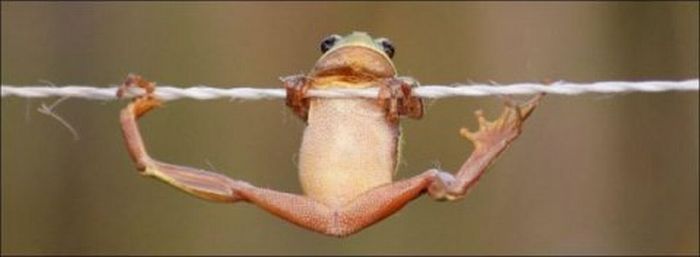|
|
Frog On A String
|
Sometimes during the tadpole stage, one of the animal's rear leg stubs is eaten by a dragonfly nymph. In some of these cases, the full leg grows anyway, and in other cases, it does not, although the frog may still live out its normal lifespan with only three legs. Other times, a parasitic flatworm called Riberoria trematodes digs into the rear of a tadpole, where it rearranges the limb bud cells, which sometimes causes the frog to have extra legs.
• Jumping
Frogs are generally recognized as exceptional jumpers, and the best jumper of all vertebrates. The Australian rocket frog, Litoria nasuta, can leap over 50 times its body length (5.5 cm), resulting in jumps of over 2 meters. The acceleration of the jump may be up to twice gravity. There are tremendous differences between species in jumping capability, but within a species, jump distance increases with increasing size, but relative jumping distance (body-lengths jumped) decreases.
While frog species can use a variety of locomotor modes (running, walking, gliding, swimming, and climbing), more are either proficient at jumping or descended from ancestors who were, with much of the musculo-skeletal morphology modified for this purpose. The tibia, fibula and tarsals have been fused into a single, strong bone, as have the radius and ulna in the forelimbs (which must absorb the impact of landing). The metatarsals have become elongated to add to the leg length and allow the frog to push against the ground for longer during a jump. The illium has elongated and formed a mobile joint with the sacrum which, in specialist jumpers such as Ranids or Hylids, functions as an additional limb joint to further power the leaps. This elongation of the limbs results in the frog being able to apply force to the ground for longer during a jump, which in turn results in a longer, faster jump.
|
|









